As digital radio will evolve slowly, free to air radio will remain relevant for a long time, media entrepreneur John de Mol predicts in an interview with Radio))) ILOVEIT.
TV producer and media investor John de Mol (1955) has been honored as Dutch Media Personality 2011 for launching a successful new format (The Voice) as well as becoming a shareholder of 3 TV channels and 100% owner of 3 radio stations with his company Talpa Media. After the award ceremony, I spoke with the former discjockey about… radio!
Producing for competing networks
2011 has been a successful year for John de Mol. He and publisher Sanoma bought SBS Broadcasting Netherlands from the German media giant ProSiebenSat.1. De Mol’s 33% share gives him access to the programming schedule of family-oriented SBS 6, young female-targeted NET 5, and young male-profiled Veronica. The 3 SBS channels are a great platform to introduce and lab-test new formats. In addition, he maintains good contacts to the 4-station family of competitor RTL Nederland – which he co-owned, but had to sell after taking over SBS (because of rules against media concentration). For their flagship RTL 4, De Mol is still producing The Voice of Holland – the original of this massively-syndicated show.
“The aspect of imagination makes radio a unique medium”
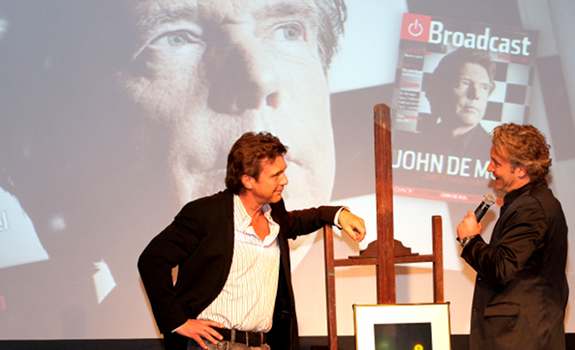
John de Mol (left) receives the Broadcaster of the Year 2011 award from last year’s winner, RTL 4 program director Erland Galjaard (right), in Hilversum on January 19th, 2012 (photo: Broadcast Magazine / Maud Berger)
Rolling out formats internationally
Meanwhile The Voice has been sold to 40 countries. The ‘blind audition’ talent show with the red turning chairs is now on-air from Denmark to Portugal and from Mexico to the US, where two major networks were both eager to buy the rights. NBC won the battle for The Voice – but CBS might sign up for Talpa Media’s most recent talent format The Winner Is… anytime soon, John de Mol recently revealed on RTL 4.
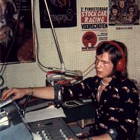 Developing passion for radio
Developing passion for radio
As his company is so focused on TV, not everyone knows that De Mol is also connected to radio. His career begins at the age of 15 at offshore pirate Radio North Sea International, managed by his father John de Mol senior. John junior’s initial job is to put records that discjockeys have been playing, back into the archive. He later works at the station full time – first as a technician, later as a presenter of a Sunday morning show.
What triggered you to start working in radio?
“I was hooked on music, so I went to the station a couple of times at nights and weekends to see what they were doing. I became indoctrinated by music, radio production, and the immediacy of radio. You open up a fader and people can hear you. In television, you have to do a lot more before people can hear and see anything. What also appealed to me was the intimacy of radio; it’s a medium where listeners can use their creativity. The aspect of imagination makes radio a unique medium.”
From temporary defeat to infinite independence
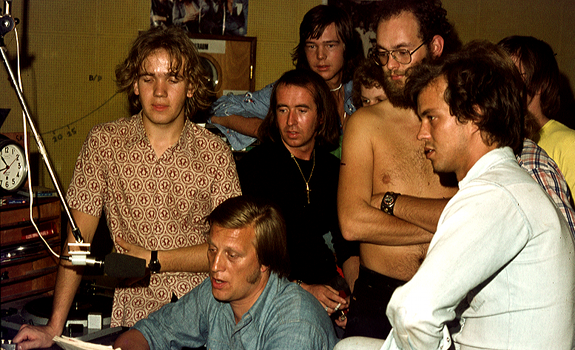
John de Mol (behind in the middle) watches as his father is reading a speech in the board studio of the MEBO II ship, on one of the last days of Radio North Sea International in August 1974. Discjockey Leo van der Goot (wears no shirt) is now television director of SBS Netherlands, for 33% owned by John de Mol’s Talpa Media (photo: Lion Keezer)
Becoming independent television producer
Who knows how his career would have developed if Radio North Sea didn’t suddenly come to an end in August 1974 when the Dutch government forces offshore stations to cease transmissions. De Mol moves on to TV. He works as a producer at public broadcaster TROS, before starting his own company. After 7 years of dealing, wheeling and nearly going bankrupt, his fortune changes. Willem van Kooten, former DJ and PD of Radio North Sea and successful in the music industry, is investing in John de Mol Productions. The hospital soap Medisch Centrum West for TROS television is his breakthrough as a producer in 1988. Six years later he partners with former rival Joop van den Ende: Endemol is born!
 Achieving lifelong creative freedom
Achieving lifelong creative freedom
Endemols involvement in a new television channel (Sport 7) in ‘96 ends in a deception, as the (media driven) public opinion turns against ‘publicly owned’ football behind payed decoders. Then Endemol makes Big Brother the next level in reality TV, allowing them to grow exponentially – the show aired in nearly 70 countries by now. When Telefónica buys Endemol in 2000 for 5.5 billion, the two founders enter the millennium as self-made men.
Launching own television channel
Backed up by these financial resources, John de Mol is launching another TV station in 2005. This free to air channel is called Talpa (Latin for ‘Mol’) and is rebranded as Tien (Dutch for ‘ten’) after the rights for this name become available. Although the station employs many stars and its (mainly self-produced) content includes high-quality drama series and football coverage, the ratings are not going through the rooftop. It doesn’t help that the station has a certain image (‘trying to buy viewers’). Two years after signing on, Tien becomes part of RTL Netherlands in exchange for a 26,3% share in RTL.
“I switched to simply buying the market leader,
which makes life a lot easier”
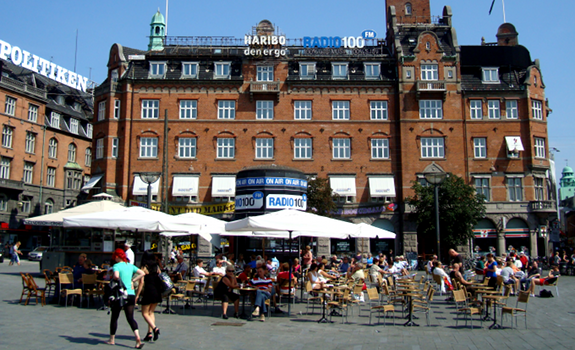
Rådhuspladsen (City Hall Square) in the Danish capital Copenhagen, with the studios of Radio 100 FM on the first floor and several billboards with the station’s logo in front and on top of the building (photo: Thomas Giger)
Investing in radio stations
Besides creating television enterprises, De Mol is also building radio assets during the 2000s. Among them are Radio 100 FM (now Radio 100) in Denmark, 4fm (now JOE fm) in Belgium, and Dutch stations Radio 10 Gold and Noordzee FM (now Q-music) – kind of a rebirth of Radio North Sea International, where his career began. During a tender for FM licenses in 2003, De Mol offers to pay over € 80 million for the 100.7 FM for Noordzee (spread over a license period of 8 years). All stations end up being sold. Despite the fact that they perform okay in the ratings – Radio 100 even becomes the top private station in Denmark – they don’t perform in terms of ROI. In Holland, De Mol drops Noordzee FM and acquires the #1 rated Radio 538.
 What are the lessons that you’ve learned from investing in radio?
What are the lessons that you’ve learned from investing in radio?
“That it’s not wise the start a station from scratch in a crowded radio market. In a mature media country such as the Netherlands, the cards have been shuffled already. Getting a foot in the door is extremely difficult. I have tried it, and it did not work. So I switched to simply buying the market leader, which makes life a lot easier.”
But you also like challenges and building things from scratch, right?
“Yes, but that’s not the way to go for radio. We have tried many things, such as Radio Digitaal (a platform of online radio stations, including branded channels, TG). It all didn’t succeed, while in the past year Radio 538 has become bigger once again, because it’s in a lot of people’s system. When people like a radio station, it’s very difficult to move them away from it. That’s much easier with TV where you can quickly create a show that people like and drag viewers from one station to another within a couple of weeks.”
“Only if I believe in the long term,
I have the patience to keep on keeping on”
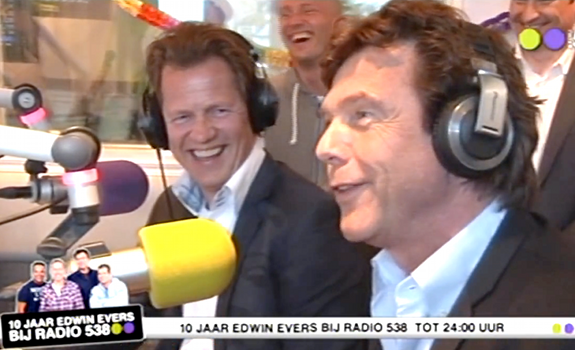
Radio 538 general manager Jan-Willem Brüggenwirth (left) and owner John de Mol (right) have fun during the all-day long 10th anniversary spectacular of the popular morning show ‘Evers Staat Op’ (screenshot: 538 TV / YouTube)
Because people are more loyal towards radio stations than they are towards TV channels? (Meaning: radio listening is more station oriented, while television watching is more program oriented?)
“Yes, plus the fact that radio shows are less distinctive than television programs, I guess. It took a good radio personality such as Edwin Evers (Radio 538 morning personality, TG) many years to finally acquire the position he has achieved. If he stays focused and disciplined, nobody comes close to him for many years”.
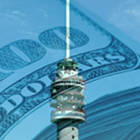 Operating a radio station in Europe is a huge investment (in terms of frequency licenses and music royalties). But aren’t you someone who rather thinks in long-term strategies?
Operating a radio station in Europe is a huge investment (in terms of frequency licenses and music royalties). But aren’t you someone who rather thinks in long-term strategies?
“Yes, but there has to be long-term potential. When you see that there is none, then you shouldn’t be blind. You should not be running up against the wall like an idiot; you’ll also need to use common sense. Only if I believe in the long term, I have the patience to keep on keeping on.”
Playing radio Stratego games
Radio 538 has a remarkable stickiness in De Mol’s dynamic media portfolio. He owns it several times as part of different business ownerships and ventures. As of January 1st, 2012, he is 100% shareholder once again, following an exchange of shares between Talpa and RTL. But for how long? Sanoma, his TV partner within SBS Netherlands, confirmed in advertising publication Adformatie to be interested in John de Mol’s radio assets. These consist not only of Radio 538 (CHR) and Radio 10 Gold (Oldies-based AC), but also of steph child SLAM!FM (Rhythmic CHR) that RTL welcomed in its home in 2011. In the first half of that year, the 3 radio stations together made an operational profit of 9 million Euros.
“When you look at the philosophy of Talpa,
radio is not necessarily a part of it”
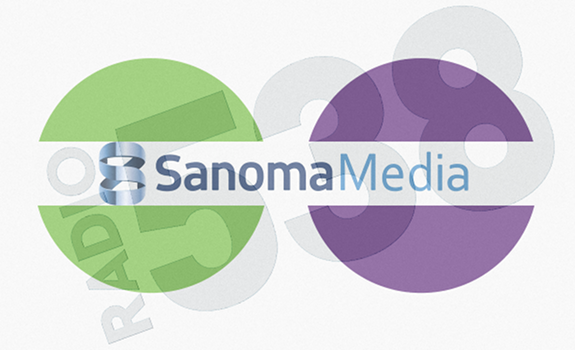
Sanoma Media is interested to broaden their Dutch media portfolio of 3 SBS TV-stations (66% share) with Radio 538, SLAM!FM and Radio 10 Gold which are in posession of John de Mol since January 1st, 2012 (graph: Thomas Giger)
You have sold Radio 538 a couple of times in the past – each time with profit. Is that going to happen again soon?
“I cannot say that. There are no plans to sell. It’s not necessary as far as I’m concerned. Radio 538 is a great company and nice to have – it’s a great business with great people, it’s music… So it doesn’t need to be sold now. But you can never predict in which major strategic games we might end up, and then it could become part of a bigger picture. But nothing is happening at this moment.”
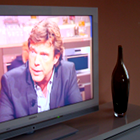 You’re focused on TV content. Understandable – it’s a much bigger platform and you can bring formats to major markets like the US. Your spokesman said that Talpa is open to sell the station if the price is right.
You’re focused on TV content. Understandable – it’s a much bigger platform and you can bring formats to major markets like the US. Your spokesman said that Talpa is open to sell the station if the price is right.
“When you look at the philosophy of Talpa, radio is not necessarily a part of it. We aim to develop unique TV content, produce it here, and sell the format internationally. In Holland it can be very nice to have radio when it comes to marketing, but within the philosophy of the company it’s not required.”
There is obviously a huge market for TV formats, but I’m sometimes wondering why internationally successful radio content hardly exists – except for a few syndicated shows such as The American Top 40. Could there be a market for radio formats in terms of universal content?
“No, I do not think so. I think that radio is a different medium which has much more creative limitations when it comes to protecting formats.”
“In a few years from now you can receive radio through
a piece of silver paper on the windshield of your car”
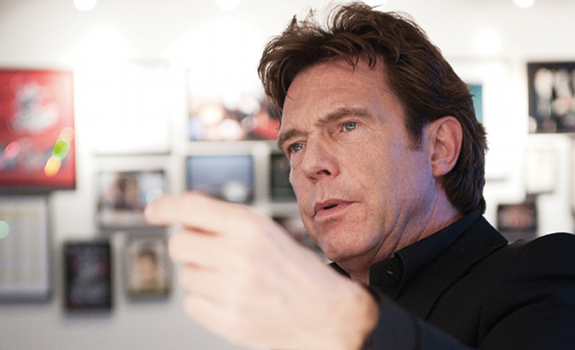
John de Mol projects that free to air radio will still be the core of the business over the next couple of years, but foresees many opportunities for digital radio in the future (photo: Broadcast Magazine / Eelco Hofstra)
You’ve been involved in radio from the offshore pirate years in the 1970s up until now. The medium has evolved through the integration with video and social media. What do you expect to be the next step in the development of radio? What should radio do to keep up with television and the Internet?
“I don’t know what radio should do. But I expect that through technology, there will be possibilities for radio that don’t exist yet. I think that in a few years from now you can receive radio through a piece of silver paper on the windshield of your car. Currently there’s still scarcity in the ether; at least in Europe there are many restrictions on FM licenses. I expect there will be an easier, more accessible market ahead of us and there it’s possible to produce digital radio. It will remain a niche business for a long time, though.”
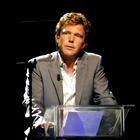 Acknowledging radio’s personal connection
Acknowledging radio’s personal connection
“Free to air radio, just like free to air TV, serves a purpose. If you’re in your car listening to Edwin Evers and you know that someone you know listens as well, you can talk about that. Radio creates a bond between people and this will never disappear. Therefore, I believe that radio will play a significant role for many years to come.” De Mol finds it “too early” to say whether or not he will invest in more (digital) radio stations in the near future.
Stay tuned, follow us @RadioILOVEIT and click below to share this post:





Add Your Comment